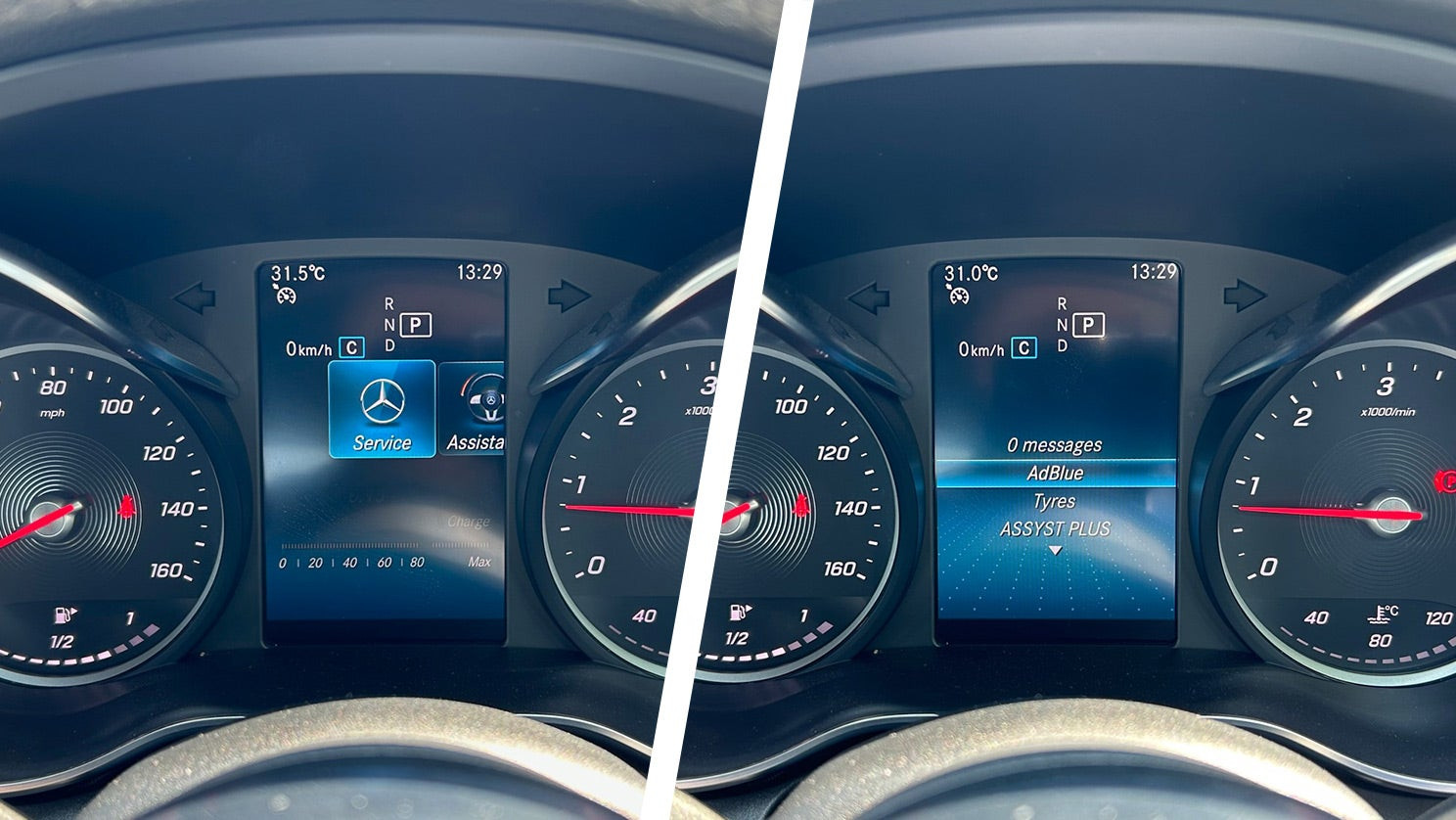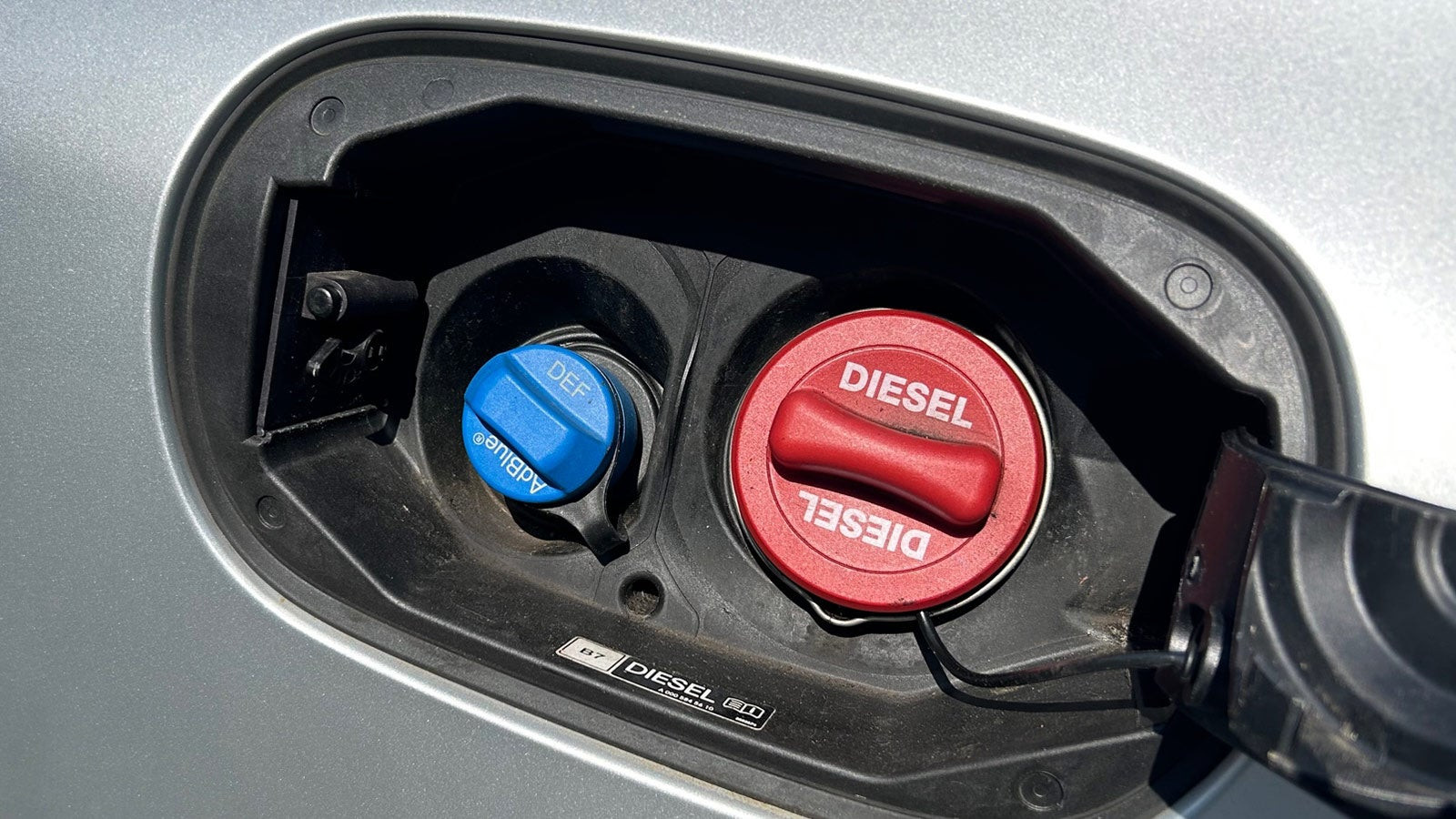How Much AdBlue Do I Put In My Mercedes? A Complete Guide

AdBlue is an essential fluid for modern diesel Mercedes vehicles, reducing harmful emissions. This guide from CARDIAGTECH.NET provides a comprehensive overview of AdBlue in your Mercedes, covering tank capacity, refill procedures, warning light resets, and tips for optimal maintenance. We’ll ensure your Mercedes runs cleanly and efficiently, meeting all emission standards.
1. Understanding AdBlue in Your Mercedes-Benz
AdBlue, also known as Diesel Exhaust Fluid (DEF), is a non-toxic solution of urea and deionized water used in Selective Catalytic Reduction (SCR) systems. These systems are standard in diesel Mercedes-Benz vehicles to reduce nitrogen oxide (NOx) emissions, helping them comply with stringent environmental regulations. Understanding the role and proper usage of AdBlue is crucial for maintaining your vehicle’s performance and longevity.
2. Why is AdBlue Important for Your Mercedes Diesel?
AdBlue plays a vital role in reducing harmful emissions from your Mercedes diesel engine. Here’s why it’s important:
- Environmental Compliance: AdBlue helps your vehicle meet strict emissions standards, reducing your environmental footprint.
- Engine Performance: The SCR system ensures optimal engine performance by reducing the buildup of harmful deposits.
- Preventing Fines: Operating a diesel vehicle without AdBlue can result in fines and penalties in many regions.
- Protecting Your Engine: Consistent use of AdBlue helps protect the catalytic converter and other exhaust system components.
3. AdBlue Tank Capacity in Mercedes-Benz Vehicles
The AdBlue tank capacity in Mercedes-Benz vehicles typically ranges from 20 to 25 liters (5.3 to 6.6 gallons). However, the exact capacity can vary based on the specific model and year. Below is a table detailing the approximate AdBlue tank capacities for some common Mercedes-Benz models:
| Model | Year | Approximate AdBlue Tank Capacity (Liters) | Approximate AdBlue Tank Capacity (Gallons) |
|---|---|---|---|
| C-Class (Diesel) | 2015-Present | 20-25 | 5.3-6.6 |
| E-Class (Diesel) | 2016-Present | 20-25 | 5.3-6.6 |
| GLC (Diesel) | 2015-Present | 20-25 | 5.3-6.6 |
| GLE (Diesel) | 2015-Present | 25-30 | 6.6-7.9 |
| Sprinter (Diesel) | 2010-Present | 22-33 | 5.8-8.7 |
| S-Class (Diesel) | 2014-Present | 25-30 | 6.6-7.9 |
| CLS (Diesel) | 2011-2018 | 20-25 | 5.3-6.6 |
| ML/M-Class (Diesel) | 2011-2015 | 20-25 | 5.3-6.6 |
| R-Class (Diesel) | 2006-2012 | 20-25 | 5.3-6.6 |
| V-Class/Vito (Diesel) | 2014-Present | 20-25 | 5.3-6.6 |
Disclaimer: These are approximate values; always consult your vehicle’s manual for exact specifications.
4. Factors Influencing AdBlue Consumption
Several factors can influence how quickly your Mercedes-Benz consumes AdBlue:
- Driving Style: Aggressive driving and frequent acceleration increase AdBlue consumption.
- Load and Towing: Carrying heavy loads or towing trailers requires more AdBlue.
- Ambient Temperature: Extremely cold or hot weather conditions can affect AdBlue usage.
- Engine Efficiency: A well-maintained engine consumes AdBlue more efficiently.
- Driving Conditions: Stop-and-go traffic and hilly terrains increase consumption.
5. How to Check Your Mercedes AdBlue Level
Checking your AdBlue level is a simple process that can be done via the vehicle’s onboard computer. Follow these steps:
- Turn on the Ignition: Insert the key and turn the ignition to the “on” position without starting the engine.
- Navigate to the Service Menu: Use the steering wheel controls to navigate to the “Service” menu in the instrument cluster display.
- Select AdBlue: Look for the “AdBlue” option in the service menu and select it.
- View the Level: The display will show the current AdBlue level, often represented as a percentage or a graphic indicating the remaining range.
5.1. Mercedes Models with MBUX System
For newer Mercedes models equipped with the MBUX (Mercedes-Benz User Experience) system, the process is slightly different:
- Start the Vehicle: Turn on the vehicle and allow the MBUX system to fully boot up.
- Access the Vehicle Menu: Use the central display screen to access the vehicle menu.
- Select “Service” or “Vehicle Information”: Navigate through the menu options to find either “Service” or “Vehicle Information.”
- Find AdBlue Level: Within the service or vehicle information menu, locate the AdBlue level display. The system will show you the current level and remaining range.
6. When and How to Refill Your Mercedes AdBlue Tank
Your Mercedes-Benz will alert you when the AdBlue level is low via a warning message on the dashboard. Here’s when and how to refill:
-
Warning Signals:
- Initial Warning: A message appears indicating low AdBlue levels and the need to refill soon.
- Secondary Warning: A more urgent warning appears with a countdown of remaining miles.
- Engine Start Prevention: If the AdBlue tank is completely empty, the vehicle may prevent engine start to comply with emissions regulations.
-
Refilling Procedure:
- Purchase AdBlue: Buy the correct type of AdBlue fluid that meets the ISO 22241-1 standard.
- Locate the AdBlue Filler Cap: This is usually located next to the fuel filler cap or in the trunk.
- Open the Cap: Unscrew the AdBlue filler cap.
- Refill Carefully: Use a funnel to pour AdBlue into the tank, avoiding spills.
- Fill to Recommended Level: Do not overfill the tank. Refer to your vehicle’s manual for the recommended fill level.
- Close the Cap: Securely tighten the AdBlue filler cap.
 Mercedes C-Class, how to check AdBlue level. Side by side showing the service menu in the instrument binnacle then the AdBlue selection.
Mercedes C-Class, how to check AdBlue level. Side by side showing the service menu in the instrument binnacle then the AdBlue selection.
Checking AdBlue level on Mercedes C-Class via the service menu.
7. Step-by-Step Guide to Refilling AdBlue in Your Mercedes
To ensure a smooth and safe AdBlue refilling process, follow these detailed steps:
-
Gather Supplies:
- Purchase AdBlue fluid meeting ISO 22241-1 standards.
- Acquire a funnel to prevent spills.
- Wear gloves to protect your skin.
- Have a clean cloth or paper towels on hand to wipe up any spills.
-
Prepare the Vehicle:
- Park your Mercedes-Benz on a level surface.
- Turn off the engine and ensure the vehicle is cool.
- Locate the AdBlue filler cap (usually near the fuel filler or in the trunk).
-
Open the AdBlue Filler Cap:
- Unscrew the AdBlue filler cap carefully.
- Place the cap in a safe spot to avoid contamination or loss.
-
Refill the AdBlue Tank:
- Insert the funnel into the AdBlue filler neck.
- Slowly pour the AdBlue fluid into the tank, being careful not to overfill.
- Monitor the fluid level as you pour, leaving some room for expansion.
-
Clean Up Spills:
- If any AdBlue spills occur, immediately wipe them up with a clean cloth or paper towels.
- AdBlue can be corrosive, so prompt cleanup is essential.
-
Close the AdBlue Filler Cap:
- Once you’ve added the appropriate amount of AdBlue, remove the funnel.
- Securely tighten the AdBlue filler cap.
- Ensure the cap is properly sealed to prevent contamination.
-
Reset the Warning Message (If Necessary):
- In some cases, the AdBlue warning message may not disappear immediately.
- Start the vehicle and allow it to run for a few minutes.
- If the warning message persists, drive the vehicle for a short distance to allow the system to recognize the refill.
8. Dealing with AdBlue Warning Lights and Messages
AdBlue warning lights and messages are designed to alert you to low fluid levels. Here’s how to handle them:
- Understand the Warnings: Familiarize yourself with the different warning messages and their urgency.
- Refill Promptly: Address the warning as soon as possible to avoid potential engine start prevention.
- Check for Leaks: If the AdBlue level drops rapidly, check for leaks around the tank and filler cap.
- Reset the System: After refilling, the system should reset automatically, but you may need to drive for a few miles.
9. Resetting the AdBlue Warning Light in Your Mercedes
After refilling the AdBlue tank, the warning light should reset automatically. If it doesn’t, try the following steps:
-
Start the Engine: Turn on the engine and let it run for a few minutes.
-
Drive the Vehicle: Drive the vehicle for a short distance (e.g., 5-10 miles) to allow the system to recalibrate.
-
Check the Display: Monitor the instrument cluster display to see if the warning light has cleared.
-
Manual Reset (If Necessary):
- In some cases, a manual reset may be required. Consult your vehicle’s manual for specific instructions.
- Typically, this involves navigating through the service menu in the instrument cluster and selecting a reset option.
 Mercedes C-Class, how to reset AdBlue warning. AdBlue filler shown next to fuel filler.
Mercedes C-Class, how to reset AdBlue warning. AdBlue filler shown next to fuel filler.
AdBlue filler location on a Mercedes-Benz C-Class.
10. What Happens If You Run Out of AdBlue?
Running out of AdBlue can lead to serious consequences:
- Engine Performance Issues: The engine’s performance may be restricted to reduce emissions.
- Engine Start Prevention: In many cases, the vehicle will prevent the engine from starting to comply with emissions regulations.
- Potential Damage: Continued operation without AdBlue can damage the SCR system.
11. Where to Buy AdBlue for Your Mercedes-Benz
AdBlue is widely available at various locations:
- Mercedes-Benz Dealerships: Purchase genuine AdBlue from authorized dealerships.
- Auto Parts Stores: Major auto parts retailers sell AdBlue in various quantities.
- Gas Stations: Many gas stations, especially those along major highways, carry AdBlue.
- Online Retailers: Online platforms like Amazon offer a wide selection of AdBlue products.
12. How Much Does AdBlue Cost?
The cost of AdBlue can vary based on the brand, quantity, and retailer. Here’s a general price range:
- Small Containers (1-5 Liters): $10 – $30
- Larger Containers (10-20 Liters): $40 – $70
- Bulk Purchases (e.g., 200-Liter Drums): $300 – $600
13. Can You Use Any AdBlue in Your Mercedes?
It is crucial to use AdBlue that meets the ISO 22241-1 standard. This ensures the fluid is of the correct quality and composition to work effectively with your vehicle’s SCR system. Using non-compliant fluid can damage the system and void your warranty.
14. Potential Problems and Solutions
- Crystallization: AdBlue can crystallize if left exposed to air. Clean any crystallized deposits around the filler cap with a damp cloth.
- Contamination: Avoid contaminating AdBlue with other fluids. Use a clean funnel when refilling.
- Sensor Malfunctions: If the AdBlue warning light remains on after refilling, there may be a sensor malfunction. Consult a mechanic for diagnosis and repair.
15. Tips for Maintaining Your Mercedes AdBlue System
- Regularly Check Levels: Monitor your AdBlue levels via the vehicle’s display.
- Use Quality Fluid: Always use AdBlue that meets the ISO 22241-1 standard.
- Proper Storage: Store AdBlue in a cool, dry place, away from direct sunlight.
- Avoid Overfilling: Do not overfill the AdBlue tank to prevent spills and potential damage.
- Routine Inspections: Have your AdBlue system inspected during regular servicing to ensure optimal performance.
16. Common Mistakes to Avoid When Refilling AdBlue
- Using the Wrong Fluid: Always use AdBlue that meets ISO 22241-1 standards.
- Overfilling the Tank: Overfilling can lead to spills and potential damage.
- Contaminating the Fluid: Keep the fluid clean and free from contaminants.
- Ignoring Warning Lights: Address AdBlue warning lights promptly to avoid engine issues.
- Improper Storage: Store AdBlue properly to prevent crystallization and degradation.
17. DIY vs. Professional AdBlue Refilling
- DIY Refilling: Refilling AdBlue yourself is straightforward and cost-effective. Follow the steps outlined in this guide.
- Professional Refilling: If you’re uncomfortable refilling AdBlue yourself or suspect an issue with your AdBlue system, consult a professional mechanic.
18. Tools and Equipment Recommended for AdBlue Refilling
Having the right tools and equipment can make the AdBlue refilling process easier and safer:
- Funnel: Prevents spills and ensures accurate pouring.
- Gloves: Protect your skin from potential irritation.
- Clean Cloth: Wipes up any spills and keeps the area clean.
- AdBlue Container: Choose a container with a pouring spout for easy handling.
For professionals and DIY enthusiasts looking for quality tools and equipment, CARDIAGTECH.NET offers a wide range of diagnostic tools and automotive equipment to assist with vehicle maintenance, including AdBlue system servicing.
19. The Future of AdBlue in Automotive Technology
As environmental regulations become stricter, AdBlue systems will continue to play a crucial role in reducing emissions from diesel vehicles. Ongoing research and development efforts focus on improving the efficiency and effectiveness of SCR technology, ensuring cleaner and more sustainable transportation.
20. How AdBlue Contributes to a Greener Environment
AdBlue significantly reduces harmful NOx emissions from diesel vehicles, contributing to cleaner air and a healthier environment. By converting NOx into harmless nitrogen and water, AdBlue helps mitigate the impact of diesel emissions on air quality and public health.
21. Understanding AdBlue Quality Standards
AdBlue quality is regulated by the ISO 22241 standard, which ensures the fluid meets specific requirements for purity, concentration, and composition. Always choose AdBlue products that are certified to meet this standard to ensure optimal performance and prevent damage to your vehicle’s SCR system.
22. Storing AdBlue Properly
Proper storage is essential to maintain the quality and effectiveness of AdBlue. Follow these guidelines:
- Temperature: Store AdBlue in a cool, dry place, ideally between 14°F (-10°C) and 86°F (30°C).
- Container: Keep AdBlue in its original, sealed container to prevent contamination.
- Sunlight: Protect AdBlue from direct sunlight, as UV exposure can degrade the fluid.
- Shelf Life: AdBlue typically has a shelf life of about two years when stored properly. Check the expiration date on the container before use.
23. Frequently Asked Questions (FAQs) About AdBlue in Mercedes-Benz
23.1. What is AdBlue, and why is it necessary?
AdBlue, also known as Diesel Exhaust Fluid (DEF), is a solution of urea and deionized water used in diesel vehicles to reduce nitrogen oxide (NOx) emissions, helping them comply with environmental regulations.
23.2. How often do I need to refill AdBlue in my Mercedes?
The frequency of AdBlue refills depends on factors such as driving style, load, and ambient temperature. Typically, a full tank of AdBlue lasts between 5,000 and 10,000 miles.
23.3. Can I use any brand of AdBlue in my Mercedes?
It is crucial to use AdBlue that meets the ISO 22241-1 standard to ensure compatibility and prevent damage to your vehicle’s SCR system.
23.4. What happens if I run out of AdBlue while driving?
If you run out of AdBlue, your vehicle may experience reduced engine performance, and in some cases, the engine may not start until the AdBlue tank is refilled.
23.5. Where can I buy AdBlue for my Mercedes?
AdBlue is available at Mercedes-Benz dealerships, auto parts stores, gas stations, and online retailers.
23.6. How do I check the AdBlue level in my Mercedes?
You can check the AdBlue level via the vehicle’s onboard computer, typically through the service menu in the instrument cluster display.
23.7. Can I refill AdBlue myself, or do I need to take it to a mechanic?
You can refill AdBlue yourself by following the steps outlined in this guide. However, if you’re uncomfortable doing it yourself or suspect an issue with your AdBlue system, consult a professional mechanic.
23.8. What are the warning signs that my AdBlue level is low?
Warning signs include a message on the dashboard indicating low AdBlue levels and the need to refill soon.
23.9. How much does AdBlue cost?
The cost of AdBlue varies depending on the brand, quantity, and retailer, but typically ranges from $10 to $70 for small to large containers.
23.10. How do I reset the AdBlue warning light after refilling?
The AdBlue warning light should reset automatically after refilling. If it doesn’t, try starting the engine, driving the vehicle for a short distance, or performing a manual reset through the service menu.
24. Need Assistance? Contact CARDIAGTECH.NET Today
Maintaining your Mercedes-Benz AdBlue system is essential for optimal performance and environmental compliance. If you encounter any issues or need assistance with your AdBlue system, don’t hesitate to contact us. Our team of experienced technicians at CARDIAGTECH.NET is here to provide expert advice, diagnostic services, and quality automotive tools to keep your Mercedes running smoothly.
Contact us today for all your automotive diagnostic and repair needs:
- Address: 276 Reock St, City of Orange, NJ 07050, United States
- WhatsApp: +1 (641) 206-8880
- Website: CARDIAGTECH.NET
At CARDIAGTECH.NET, we understand the challenges faced by automotive technicians. We offer solutions that enhance efficiency, accuracy, and safety. Whether you’re a young mechanic starting your career or a seasoned shop owner, our tools and equipment are designed to meet your needs. Contact us today and let us help you elevate your service and boost your profits.
Remember, keeping your Mercedes-Benz in top condition ensures a smooth, efficient, and environmentally friendly driving experience.




